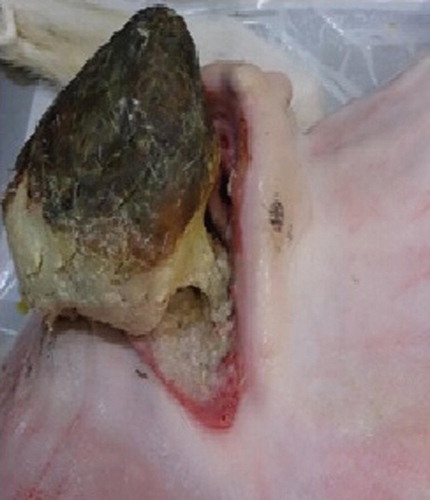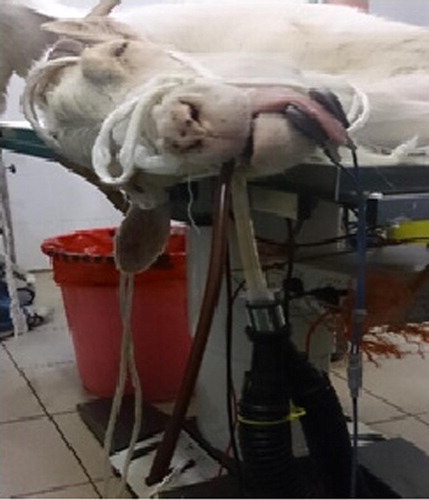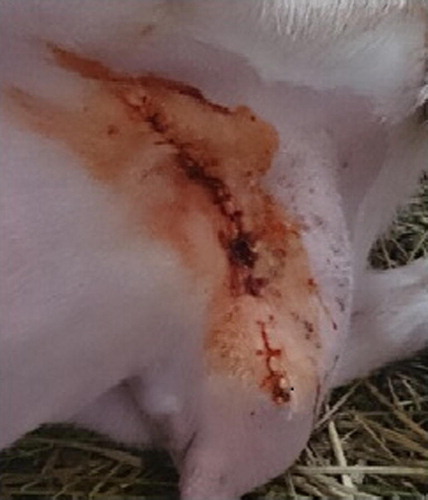Abstract
A four-year-old Saanen goat, weighing 52 kg, was referred to the Department of Obstetrics and Gynaecology clinic with black discoloration of the left mammary gland. The goat’s general condition was not good upon initial examination. The goat was anorexic, lethargic, and febrile (rectal temperature of 40 °C) with a palpably cold left mammary gland on which there was an accumulation of pus. Somatic cell count (SCC) was measured as 820,000/ml in the milk sample collected from the infected gland, and Staphylococcus aureus was isolated. Gangrenous mastitis was diagnosed on the left mammary gland of the goat based on the clinical findings. To treat the condition, a unilateral mastectomy was performed successfully. The goat was fully recovered a week after surgery. This case aimed to establish a surgical approach of unilateral mastectomy as a treatment option for goats with gangrenous mastitis while allowing the other mammary gland to continue lactation. Thus, it can be concluded that unilateral mastectomy is a viable alternative treatment of goats with gangrenous mastitis.
1 Introduction
Caprine mastitis is a very serious and important problem in goat breeding which may lead to a decline in the overall health [Citation1,Citation2]. Although various pathogens may lead to the onset of this disease, predisposing factors may also play a major role. Predisposing factors include poor management and hygiene, including conditions related to mountainous environment as well as faulty or irregular milking of the animals leading to teat injuries, and the narrowing of the teat canal and teat [Citation1–Citation5]. Gangrene of a mammary gland was observed following acute mastitis in a previous report [Citation6]. One of the most important causative agents in subclinical, chronic, and acute caprine mastitis is Staphylococcus aureus. However, a combined infection of S. aureus, Clostridium perfringens, and Escherichia coli in a Boer goat with gangrenous mastitis has been reported [Citation7]. Additionally, Corynebacterium sp., coagulase-negative Staphylococcus, Enterococcus faecalis, and Staphylococcus sp. were also reported to be isolated from goats with gangrenous mastitis [Citation8], but S. aureus is responsible for a more severe form of the disease [Citation9]. This case aimed to establish the surgical approach of unilateral mastectomy as a treatment option for goats with gangrenous mastitis, while allowing the other mammary gland to continue lactation.
1.1 Case history and clinical findings
A four-year-old Saanen goat, weighing 52 kg, was referred to the Department of Obstetrics and Gynaecology clinic with 1-month complaint of black discoloration of the left mammary gland. The goat had undergone parturition 40 days prior to presentation. Physical examination revealed an elevated rectal temperature, anorexia, dyspnea, and reluctance to walk. The left mammary gland was black with a purulent lesion and was cold on palpation (). Also, a hemorrhagic purulent discharge was present during milking.
2 California mastitis test evaluation and scoring
California mastitis test (CMT) solution (DeLaval, Cardiff, UK), consisting of 3% sodium lauryl sulfate and bromocresol, was mixed in equal amounts with the collected milk sample. CMTs were scored as follows: 0 = no reaction, (+) = weak positive, (++) = distinct positive, and (+++) = strong positive.
2.1 Somatic cell count
SCC was measured using a Fossomatic 90 instrument (Foss Electric, Hillerod, Denmark) following a 40 °C heat treatment for 15 min [Citation10].
2.2 Microbiological examination
A milk sample collected from the infected gland was sent to the microbiology department for examination and antimicrobial agent selection. Microorganisms were isolated and identified based on macroscopic and microscopic morphology determined by Gram staining, culture characteristics, and biochemical features [Citation11]. In vitro susceptibility tests, were performed on the isolate, according to the guidelines from the Clinical and Laboratory Standards Institute (CLSI), in order to select the most effective antimicrobial agent. Bacterial resistance was determined by the measurement of inhibition of growth around the antimicrobial disks according to the zone diameter interpretative standards of the CLSI [Citation12]. Antibiotic susceptibility test results are shown in .
Table 1 Antibiotic selection and susceptibility test results.
3 Pre-treatment and surgical excision
The goat had not received any medication previously. Milk samples were collected immediately from both mammary glands for CMT and SCC evaluation. The left mammary gland’s CMT score was recorded as (+++); the right mammary gland’s score was 0 (no reaction) and was designated as healthy. The SCC was found to be 820,000/ml in the sample collected from the left mammary gland, and <250,000/ml in the sample from the healthy gland. All milk samples were aseptically collected and sent to the microbiology department for microbial examination. The isolate from the infected mammary gland’s milk sample was identified as S. aureus based on observations of its cultural and biochemical properties, including coagulase activity [Citation11]. No bacteria were isolated from the other mammary gland, classifying it as healthy. Gangrenous mastitis was diagnosed on the left mammary gland according to the clinical symptoms, increased SCC, and bacterial culture results. Initially, the goat’s general condition was restored by administration of non-steroidal anti-inflammatory drugs (NSAIDs), an antibiotic, vitamins (vitamin B and vitamin C combination), and Lactated Ringer’s solution for one week. Antibiotic teat infusions were also used but proved ineffective. A decision was made to perform a unilateral mastectomy of the infected mammary gland. Food and water were withheld from the animal for 12 h prior to surgery. Fifty μg/kg xylazine hydrochloride (Rompun, Bayer, Turkey) intramuscularly for sedation and 5 mg/kg ketamine hydrochloride (Ketalar, Abbott Laboratuvarı A.Ş., Turkey) was administered intravenously for general anesthesia. Subsequently the goat was intubated with a cuffed tube. Intubation was carried out with the help of a laryngoscope. Anaesthesia was maintained with a combination of 3% isoflurane and Oxygen. A stomach tube was used to support gas relief (). The surgical site was shaved and disinfected. An elliptical skin incision was made around the base of the left udder (unilateral mastectomy). The skin was dissected from the glandular tissue and body wall. The glandular tunic was separated from the abdominal tunic and large vessels. Superficial caudal epigastric vessels, external pudendal, and perineal blood vessels were ligated tightly with No. 2 absorbable suture material. All of the glandular tissues and the lymph nodes were removed. Also, all other blood vessels between the udder halves were ligated tightly. The subcutaneous fascia was closed with No. 1 absorbable suture material by simple suturing. The skin was sutured with No. 2 non-absorbable suture material. The goat was extubated subsequent to waking up from anesthesia and was transferred to a recovery room with a straw covered floor.
4 Post-operative care
Ten mg/kg amoxicillin/clavulanic acid (Synulox® flacon, Pfizer, Turkey), and 0.6 mg/kg of meloxicam (Zeloxim® ampul, Bilim Pharmaceuticals, Turkey) were administered once daily, intramuscularly, for one week post-surgery. Antiseptic iodine solution was administered topically to the sutures once a day for one week. The goat was fully recovered one week after the operation. The skin sutures were removed ten days post-surgery () and no problems were observed regarding the surgical site.
5 Discussion
The objective of the present case report was to establish the surgical approach of unilateral mastectomy to treat gangrenous mastitis in goats as an alternative to medical treatment with antibiotics or supportive therapy, both of which reportedly offer limited value [Citation13]. In a goat with gangrenous mastitis, a specific antitoxin therapy with enterotoxin-secreting S. aureus has been recommended rather than antibiotic therapy [Citation13]; however, the efficacy of this therapy could not be confirmed in the mentioned study due to the death of the goat. Therefore, in the present case, the decision was made not to risk the goat’s life and instead, a unilateral mastectomy was performed on the infected gland. Sastry [Citation14] reported that S. aureus and E. coli + Clostridium welchii could lead to gangrenous mastitis; in this case, S. aureus was identified as the causative agent. According to Peer and Bhattacharyya [Citation15] the highest prevalence (40%) of mastitis was observed in goats 1–6 years of age. The goat in the current case was 4 years old and in line with the mentioned average age. El-Maghraby [Citation16] reported that bilateral radical mastectomy was technically easier to perform than unilateral mastectomy, since between the two halves of the udder, there are several interconnecting blood vessels that need to be ligated during unilateral mastectomy. In the current case, since only the left udder was infected and it was hoped that the goat would continue to lactate, a unilateral mastectomy was performed eventhough it was reported to be more difficult than bilateral mastectomy. In chronic mastitis, gangrenous lesions or neoplastic cases where medical treatment is a limited choice, unilateral or bilateral mastectomy is recommended [Citation17,Citation18]. Monsang et al. [Citation19] fixed a fenestrated catheter at the ventral skin suture to drain any fluid accumulation or seroma beneath their sutures. In the current case, a catheter was not placed because the subcutaneous tissue was tightly sutured, bleeding was avoided by ligation during surgery, and no discomfort was observed related to fluid accumulation. Radical mastectomy (unilateral or bilateral) is a salvage procedure in the cases of gangrenous mastitis, neoplasia or hyperplastic conditions of the udder. For goats with gangrenous mastitis, unilateral mastectomy can be an option that will allow the other mammary gland to continue lactation. Thus, it is concluded that unilateral mastectomy can be a viable alternative in the treatment of goats with gangrenous mastitis.
Notes
Peer review under responsibility of Faculty of Veterinary Medicine, Cairo University.
References
- M.M.LewterR.D.WalkerMastitis in goatsCompend Contin Educ Pract Vet671984417425
- M.T.Abu-SamraS.M.ElsanousiM.A.AbdallaA.A.GameelM.AbdelazizB.AbbasK.E.E.IbrahimS.O.IdrissStudies on gangrenous mastitis in goatsCornell Vet781988281300
- N.E.EastE.F.BimieT.B.FarverRisk factors associated with mastitis in dairy goatsAm J Vet Res4851978776779
- J.HammanM.EitamRelevance of machine induced teat tissue reaction in cows for improvement of machine milking in small ruminantsSheep Dairy News1019932931
- Magic B, Jonanovic Bunta V, Ljublic Z, Kukovics S. Typical problems encountered in Croatia in the operation of goats milking machines. In: Proceedings of the fifth international symposium on machine milking of small ruminants, Budapest, Hungary; 14 May, 1993. p. 377–9.
- C.YeshwantkumarG.C.NirmalaSurgical management of gangrenous mastitis in a pregnant goatVet World182008250
- M.G.RibeiroG.H.B.LaraS.D.BicudoA.V.G.SouzaT.SalernoA.K.SiqueiraJ.S.GeraldoAn unusual gangrenous goat mastitis caused by Staphylococcus aureus, Clostridium perfringens and Escherichia coli co-infectionArq Bras Med Vet Zootec5932007810812
- F.BurgosE.AlmeidaRadical and unilateral mastectomy as treatment of choice for gangrenous mastitis in goatsMed Vet732013712
- E.C.WhiteL.S.HinckleyPrevalence of mastitis pathogens in goat milkSmall Rumin Res331999117121
- A.SederviousJ.BalsyteK.LukauskasJ.KazlauskaiteG.A.BiziuleviciusAn enzymatic cow immunity-targeted approach to reducing milk somatic cell count: 3. A comparative field trialFood Agric Immunol17200617
- P.J.QuinnM.E.CarterB.K.MarkeyG.R.CarterClinical veterinary microbiology1999Harcourt Publishers LimitedLondon
- CLSI. Performance standards for antimicrobial disk and dilution susceptibility for bacteria isolated from animals: approved standard. 2nd ed. Wayne; 2008, p. 65–72.
- D.M.BezekB.L.HullPeracute gangrenous mastitis and cheilitis associated with enterotoxin-secreting Staphylococcus aureus in a goatCan Vet J361995106107
- G.A.SastryVeterinary pathology7th ed.2001CBS Publishers and DistributorsDelhip.226–7
- F.U.PeerH.K.BhattacharryyaStudies on caprine gangrenous mastitisIndian J Small Rumin13120079294
- H.El-MaghrabyComparison of two surgical techniques for mastectomy of goatsSmall Rumin Res402001215221
- C.B.AndreasenM.J.HuberJ.S.MattoonUnilateral fibroepithelial hyperplasia of the mammary gland in a goatJAVMA202199312791280
- C.S.CableK.PeeryS.L.FubiniRadical mastectomy in 20 ruminantsVet Surg332004263266
- S.W.MonsangS.K.PalM.KumarJ.RoyC.S.SharmaM.N.SinghBilateral mastectomy for successful management of chronic suppurative mastitis in a black Bengal doe (Capra Hircus)J Anim Health Prod2220142830



